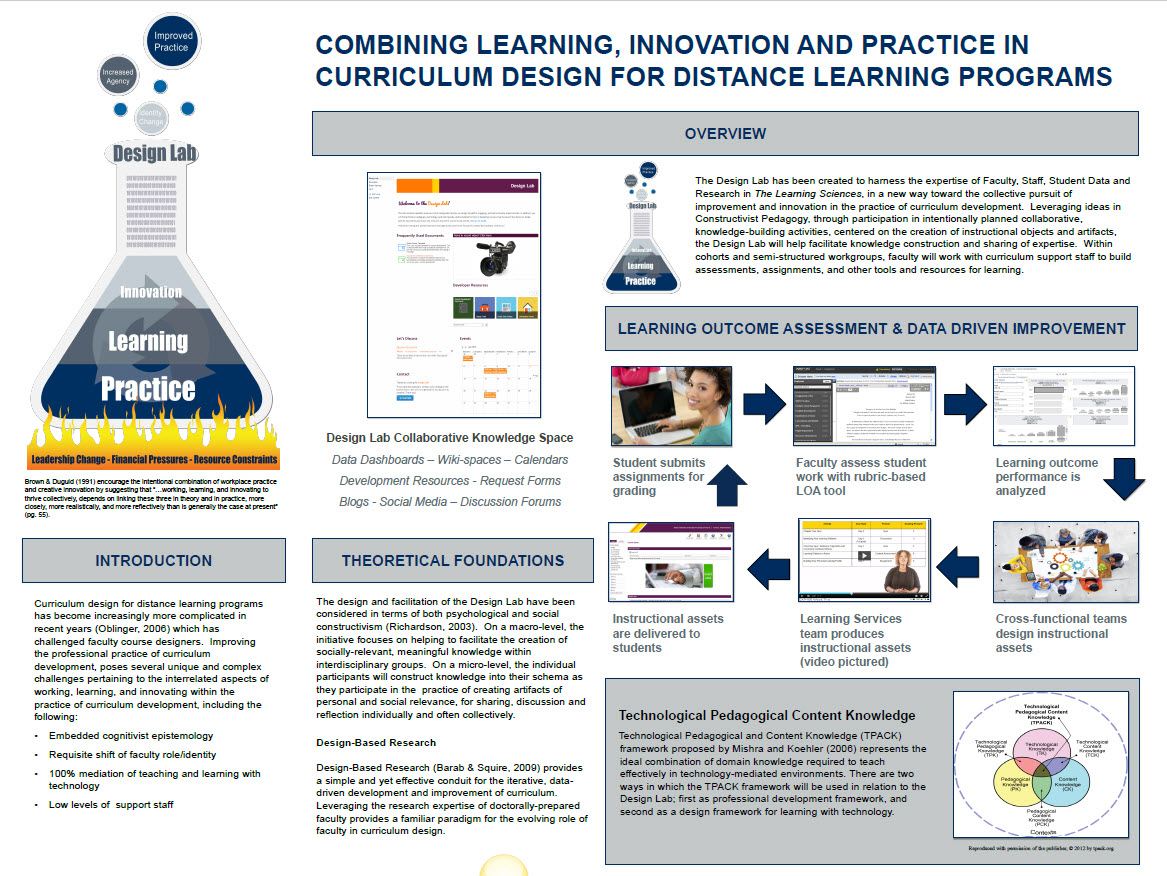Design Lab: Combining Learning, Innovation and Practice in Curriculum Design for Distance Learning Programs
Strategic Management of Organizational Change:
An intentional approach to change management has been implemented in the conception and implementation of the Design Lab initiative, much of which is drawn from the literature of innovation and change. The implementation of the Design Lab project has been organized into three phases. Because the project has been in motion for some time, portions of the first two phases of the proposal have already been completed, and will be described in past tense reflectively. The phases include Preparation and Planning which has already concluded, Relationship and Community Building which is currently the focus, and finally Ongoing Management and Iterative Improvement to continue into the future. Each phase contains specific objectives used to guide the implementation and ongoing management of the initiative.
Preparing and Planning
Though significant aspects of the groundwork for the Design Lab initiative had been laid for several years leading up to formal discussions, the initiative will be considered to have officially began with the formation of the core leadership team overseeing the development of curriculum at Online University in early 2015. At the core of the group, or Guiding Coalition (Kotter, 1995) are the Provost/CLO, the Vice Provost of Curriculum and Innovation, all five Deans of the four academic Colleges and Division of General Education, the V.P. of Assessment, and are supported by the Executive V.P./Chief Academic Officer and other senior leadership from the parent organization. The depth and span of the guiding coalition is formidable and will also need to be managed to ensure continued cohesiveness and effectiveness.
As the AVP of Curriculum and Instructional Design, I am the operational leader of the initiative, managing the daily decisions, proposing plans for implementation, and reporting back on progress. In this role, I will both leverage existing Social Capital (Portes, 1998) and a recently increased span of influence over the curriculum and technology teams to help bring the vision into a reality. Previous successes in redesigning the classroom, designing a an asynchronous orientation session that changed the way students were on boarded, and adding a global item in all courses that provides 2 minute or less videos that address common student problems and questions, have all increased my personal visibility in the organization and the network of others built working with people in cross-functional groups.
In April of 2015, as a result of efforts to increase the efficiency and collaboration of the OU curriculum development a reorganization of staff resulted in the addition of 14 additional people to my reporting structure, 4 Program Managers and 10 Curriculum Specialists. Having direct reporting relationships with an increased number of participants in the process has allowed for a more efficient change in processes and culture with the group, and increased the scope of influence of the Design Lab itself by removing operational barriers within the domain of my control.
Drivers of Change
The cultural environment of Online University has been challenged recently by several interrelated reasons. In the broader online learning marketplace, web, television and radio ads have become saturated in recent years with commercials for higher-education providers accessible through distance learning technology, increasing competition for students. As more and more schools have taken their curriculum online, the marketplace has become crowded and institutions have been challenged to differentiate their brand and offerings in response. The rapid scalability of institutions with online course offerings, pressures the market, even though it is actually increasing in size. According to a 2013 report from the Babson Survey Research Group, enrollment in at least one online course has increased from under 10% of total student enrollment in 2002, to over 35% of total enrollment in 2011, (Allen & Seaman, 2013).
To adjust to lowered student enrollment and operating revenue for the university, Reductions in Force have become a seasonal expectation, and the cultural climate has been negatively impacted each time. The culture has evolved into one which operates under the fear of loss, and as a result has led to increased attrition, lowered employee engagement scores and a general air of tension. Resultantly, staff and faculty alike are more receptive to institutional directives and initiatives that are developed and supported by university leadership. Being perceived as a team-player and as having an organization wide perspective in the design and implementation of initiatives, has become a security blanket in the midst of turbulent times.
A significant driver in the implementation of the Design lab was the sense of urgency created as a direct result of two projects led by the Provost of Online University which have emphasized the use of data and research methods to improve curriculum metrics. One project targeted the 50 most performing courses in the university for data-driven improvement, while the other involved publishing design research on Worked Examples with well-known Cognitive Load Theorist, and cognitive researcher, John Sweller, professor Emeritus at University of New South Wales, in Sydney Australia. A brief description of each will be provided below to highlight the essential elements of empowerment of curriculum development faculty and the creation of short term wins through collaborative efforts to improve specific problems in OU courses and programs.
In early 2015, under the direction of the Provost, and supported by several key members of the guiding coalition, the Top 50 Course Project was initiated. The Dean of each college was tasked to improve the measured performance of the lowest 10 performing courses in their area curricular area over the course of a year. Academic Deans and other leaders in Assessment and Instructional Design and Quality Assurance met with each of the four Colleges and the Division of General Education, to discuss ideas about how to approach working with faculty to strategically intervene with curriculum change. Invoking the thinking of Tim Brown and his published work on Design Thinking, leadership of the Top 50 project were encouraged to think differently about the issues being addressed specifically displaying the characteristics of design thinkers with regard to the”…willing and enthusiastic acceptance of competing constraints is the foundation of design thinking.” (pg.17)
With this charge, the academic leadership from each college met over several months forming subgroups and working across normal organizational lines to help provide solutions and interventions. This initiative brought course data and performance improvement to the forefront of the conversation surrounding curriculum development, and represented a significant change in expectations about the role and accountability of the academic leadership related to course performance. For the first time, the Executive Deans of the colleges were made responsible and empowered to engage in the ongoing, iterative improvement of the curriculum which was very impactful in supporting the collaborative elements of the Design Lab.
Through this and similar work, the ongoing dialogue with leadership and faculty have evolved to center on a collective vision of creating meaningful and effective learning experiences for students, through intentional, coordinated efforts, maximizing resources and leveraging the available Rich Data in thoughtful and productive cross-disciplinary collaboration.
Example: Worked Examples Research with John Sweller.
In the fall of 2014, faculty of Online university were invited to apply for University Fellows Grants of up to $10,000 for research performed related to issues of teaching and learning. One grant winning team, led by the provost, the department chair in Psychology, the AVP of Instructional Design and Curriculum, along with a group of faculty from a variety of curriculum areas proposed to measure the effects of Worked Examples in ill-defined domains (Kyun, Kalyuga & Sweller, 2013)
Similarly to the top 50 course project described above, faculty were responsible for selecting the courses, assignments, and explanation types chosen as a target of a design intervention, but in this case, the tool was predetermined to be a Worked Example (Paas, Renkl, & Sweller, 2003), in accordance with the design and nature of the study. With help from the instructional design and technology teams, collaborative working sessions were designed and facilitated to combine learning and innovation with practice, in the creation of worked examples for specific curriculum related problems. Over a period of several months, faculty met for 90 minutes through adobe Connect web conferencing platform, and talked through the creation and iteration of each other’s examples.
While still in the development phase of the design intervention, the of the Worked Examples research project the faculty and staff involved have created new and exciting ways to target and intervene in difficult instructional problems through leveraging of Worked Examples, and have created an excitement and a buzz around the pending publication opportunity. The success of these initiatives and others will be highlighted regularly to the larger academic body through the Faculty Focus, monthly newsletter, announcements and messages from the Provost and other leadership and will serve to provide encouragement of sustained effort in the change initiative (Kotter, 1995)
Relationship and Community Building
One of the challenges of working with a distributed workforce, within a large organization is the ability to maintain consistent, high-impact communication for the purposes of building a common culture and sense of community. Historically, communication of initiatives and information to the thousands of faculty and staff of Online University have lacked both consistency and creativity, often times resulting in what is perceived as an information vacuum from those not tightly connected to the day to day operations of individual initiatives. For the last year, the In conjunction with the OU Design Lab initiative, technology will be leveraged to attempt to mitigate the communications challenges of the past. Focusing on multiple channels of communication modalities, leveraging traditional and non-traditional media alike, social media platforms such as Pinterest, Facebook and Twitter can be easily utilized help to connect people with ideas and discussion around topics and objects of interest to the design lab community. The affordances of these tools allow for news and information to be shared in ways that are already integrated into the daily practices of most people, empower participants to act on the vision with their own agency as a driver and of a true participant centered community.




